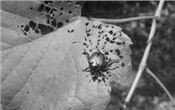Flooding Unlikely To Affect Japanese Beetle Populations

Japanese beetles enjoy dining on more than 300 host plant species.
Photo credit: Chuck Bargeron, University of Georgia, Bugwood.org
COLUMBIA, MO.
Even long-lasting floodwaters have little effect on invasive Japanese beetles that have begun to emerge in central Missouri, says Kevin Rice, University of Missouri Extension field crops entomologist.
History shows that the beetles even survived the large-scale flooding on the East Coast of the U.S. in the 1940s.
Adult beetles feed on more than 300 host plant species, including natural weeds, shrubs, hardwoods, fruit, ornamentals, and field crops such as corn and soybean.
The beetle grubs overwinter in the upper 5-10 inches of soil, says Rice. They resume feeding on grass root in the spring prior to adult emergence.
Standing water in fields reduces the availability of oxygen and can enhance the spread of crop disease, but it is unlikely to suppress beetle populations, he says.
Adults will continue to emerge throughout early summer, with peak populations typically occurring in July, says MU entomologist Ben Puttler.
Adults can severely defoliate soybean leaves and affect yield. Producers should consider insecticide applications when 30 percent defoliation is observed during vegetative growth and 20 percent during reproductive stage.
This year’s late-planted soybean may reach thresholds earlier because plants will be smaller.
Groups of Japanese beetles gather in field edges. “Therefore, border treatments may provide sufficient management,” says Rice. But he also recommends scouting the interior area of fields.
Adult beetles also consume corn silks. This results in reduced pollination and ear fill. However, foliage feeding does not cause injury. When silks are present, Rice recommends applying insecticide if there are three or more beetles per ear and pollination is less than 50 percent complete.
Rice and other MU researchers are investigating an attract-and-kill strategy to manage Japanese beetles while reducing insecticide applications. The technique uses lures containing pheromones and plant volatiles to attract adult beetles to a specific area. ∆